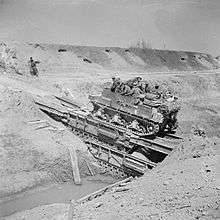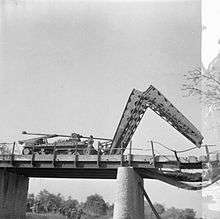Armoured Vehicle Royal Engineers

Armoured Vehicle Royal Engineers (AVRE) is the title given to a series of armoured Military engineering vehicles operated by the Royal Engineers (RE) for the purpose of battlefield engineer support. These vehicles have been either purpose-built or post-production modifications of existing tank-based armoured vehicles. A common feature of most AVREs to date has been the retention of a large calibre main gun or its replacement by a weapon of a larger calibre. The most recent vehicle to be called an AVRE is the Challenger 2-based Trojan; however this vehicle breaks the trend by not having a large calibre weapon.[1] With the multitude of functions now required of the RE, new vehicles have come into use which are given alternative names, but which are to all intents and purposes, AVREs.
History

World War One
The first vehicle that can be considered to be an AVRE is the Heavy RE tank developed shortly after World War I by Major Giffard LeQuesne Martel RE.[1] This vehicle was a modified Mark V tank. Two support functions for these AVREs were developed: bridging and mine clearance. The bridging component involved an assault bridge, designed by Major Charles Inglis RE, called the Canal Lock Bridge, which had sufficient length to span a canal lock. Major Martel mated the bridge with the tank and used hydraulic power generated by the tank's engine to manoeuvre the bridge into place. For mine clearance the tanks were equipped with 2 ton rollers.
Between The Wars
Between the wars various experimental bridging tanks were used to test a series of methods for bridging obstacles and developed by the Experimental Bridging Establishment (EBE). Captain SG Galpin RE conceived a prototype Light Tank Mk V to test the Scissors Assault Bridge. This concept was realised by Captain SA Stewart RE with significant input from a Mr DM Delany, a scientific civil servant in the employ of the EBE.
MB Wild & Co, Birmingham, also developed a bridge that could span gaps of 26 feet using a complex system of steel wire ropes and a travelling jib, where the front section was projected and then attached to the rear section prior to launching the bridge. This system had to be abandoned due to lack of success in getting it to work, however the idea was later used successfully on the Beaver Bridge Laying Tank.[1][2]
World War Two
Once World War Two had begun, the development of armoured vehicles for use by engineers in the field was accelerated under Delaney's direction. The EBE rapidly developed an assault bridge carried on a modified Covenanter tank capable of deploying a 24-ton tracked load capacity bridge (Class 24) that could span gaps of 30 feet. However, it did not see service in the British armed forces, and all vehicles were passed onto Allied forces such as Australia and Czechoslovakia.[1][3]
A Class 30 design superseded the Class 24 with no real re-design, simply the substitution of the Covenanter tank with a suitably modified Valentine.[1] As tanks in the war got heavier, a new bridge capable of supporting them was developed. A heavily modified Churchill used a single-piece bridge mounted on a turret-less tank and was able to lay the bridge in 90 seconds; this bridge was able to carry a 60-ton tracked or 40-ton wheeled load.[1]
The first bridge to equip an AVRE Churchill was the Tank Bridge, Box Girder. This equipment bridged gaps of 30 feet, but could also be used to cross 12-foot seawalls or other similar obstacles. The Churchill ARK (Armoured Ramp Carrier) was a flexible design, where the tank itself was the "bridge". Multiple vehicles could be used to span gaps in both the vertical and horizontal. The tank had the turret removed and trackways fitted to the hull. Ramps were attached at each end of the trackways extending the bridging potential and allowing its use in difficult terrain. The tank would need recovery after its use was no longer required.[1]
List vehicles deployed



- Mark I tank Heavy RE tank variants
- Bridgelayer, a Mark V tank, with canal lock bridge
- Mine clearer, a Mark V tank, with mine rollers
- Bridgelayer, scissors assault bridge
- Bridgelayer, deploying a Class 24 scissors bridge
- Valentine Mk II, deploying a Class 30 scissors bridge
- Churchill AVRE numerous variants
- Was a Churchill Mk III armed with a 290 mm Petard spigot mortar,[4] its turret was of welded construction
- A Churchill Mk IV, which had a cast turret. Post-war, the Churchill AVRE was re-armed with a short barrelled L9A1 165 mm demolition gun which fired a 64 lb (29 kg) HESH round[1]
- Centurion tank variants
- FV4003 Centurion Mk 5 AVRE. Armed with a short barrelled L9A1 165 mm demolition gun, it entered service in 1963, replacing the Churchill AVRE[1]
- FV4203 Centurion Mk 12 AVRE. A modified Artillery Observation Post vehicle, it was armed with the conventional 105 mm Royal Ordnance L7 rifled gun
- Chieftain tank variants
- The Willich Chieftain AVRE entered service in 1987. This vehicle was designed by Capt D Clegg MBE RE. The vehicle was built by 32 Armoured Engineer Regiment and 21 Engineer Base Workshop of the Royal Engineers under the direction of Lt Col JF Johnson RE based in the German town of Willich, hence its name[5]
- The Chieftain AVRE entered service in 1994. 48 units were produced by Vickers Defence Systems
- 143 units were supplied,[6] it entered service in 1977
- Shielder Vehicle Launched Scatterable Mine System
- Essentially a modified BAE Systems Land Systems Stormer with the Alliant Techsystems Volcano mine delivery system, 30 have been delivered[7][8][9]
- Challenger variants
- Trojan Combat Engineer Vehicle (CEV), based on the Challenger 2 chassis, the Trojan will be equipped with an articulated excavator arm, a dozer blade and rails for fascines. 33 units have been ordered from BAE Systems Land Systems
- Titan AVLB, also based on the Challenger 2 chassis, the Titan Armoured Vehicle Launched Bridge, 33 units have been ordered from BAE Land Systems
- Terrier CET
- Currently in development to replace the FV180. Substantial use of Commercial off-the-shelf parts is part of the design of the vehicle, including a Caterpillar drive train (C18 diesel engine and an X300 series automatic transmission) and excavator. It also uses the alloy road wheels from the BAE Systems Combat Vehicle 90 programme. The Terrier is armoured using steel rather than the aluminium alloy of its predecessor[6]
See also
Notes
- 1 2 3 4 5 6 7 8 9 Archived May 27, 2008, at the Wayback Machine.
- ↑ "Canadian Defence Force Website". Army.ca. Retrieved 24 November 2014.
- ↑ "Czechoslovakian Service". Masenoviny.com. Archived from the original on 2 December 2014. Retrieved 24 November 2014.
- ↑ "Popular Mechanics". Books.google.com. Retrieved 24 November 2014.
- ↑
- 1 2 "BAE brochure on Armoured Engineer Vehicles" (PDF). Jdw.janes.com. Retrieved 24 November 2014.
- ↑ "Hansard". Publications.parliament.uk. Retrieved 24 November 2014.
- ↑ "Shielder specifications - basic language". Atk.com. Retrieved 24 November 2014.
- ↑ Archived September 28, 2007, at the Wayback Machine.
References
- Crusader and Covenanter Cruiser Tanks 1939-45, David Fletcher, Osprey Publishing, ISBN 1-85532-512-8
- The Encyclopedia of Weapons of World War Two, Editor Chris Bishop, Metro Books. ISBN 1-58663-762-2
External links
| Wikimedia Commons has media related to Armoured Vehicle Royal Engineers. |